2007 VOLKSWAGEN GOLF PLUS seats
[x] Cancel search: seatsPage 58 of 541
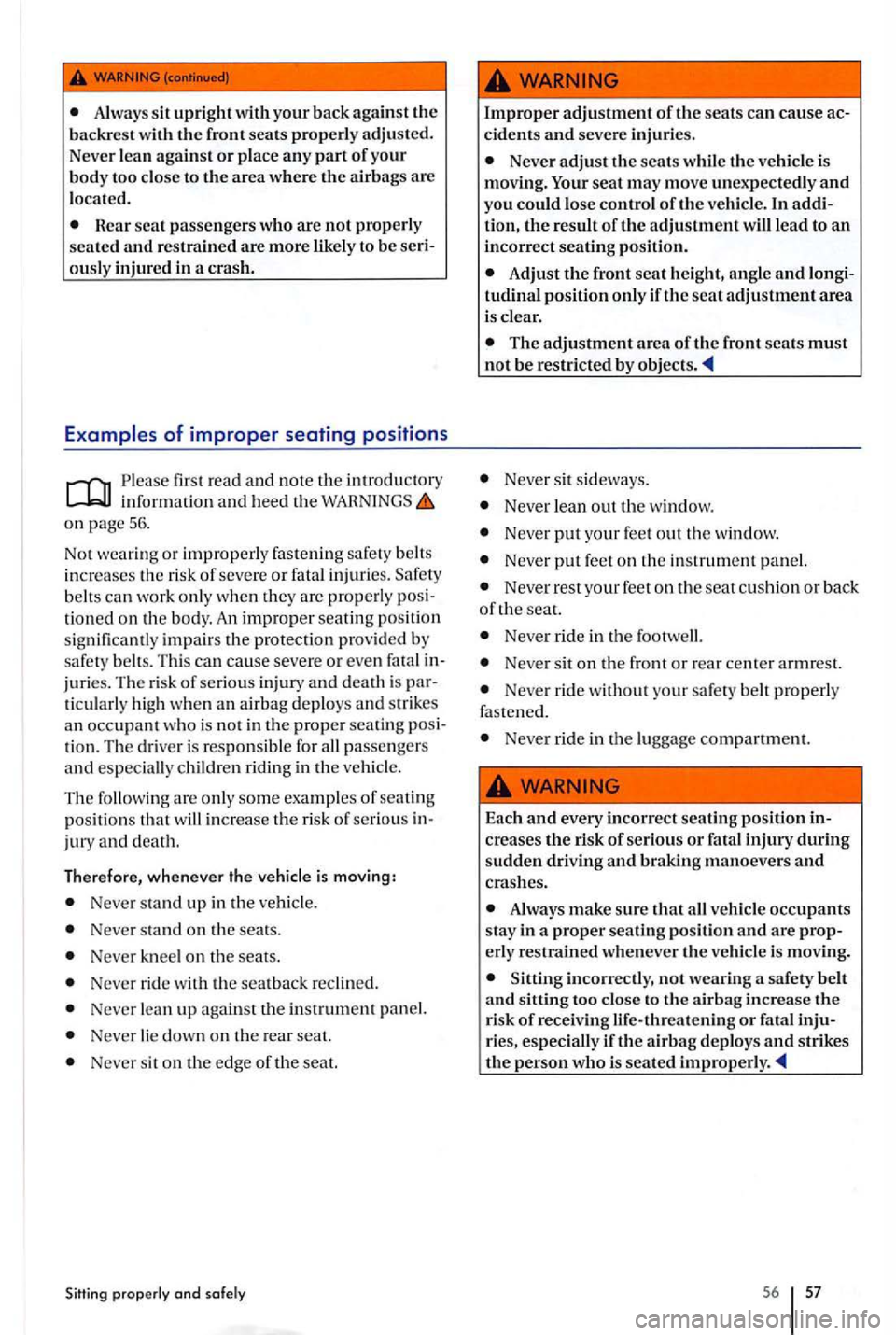
Always upright your back agains t the backrest with the front seats properly adjusted.
Never lean agains t or pla ce any part of you r
body too close to the area where the airb ags are
l oca ted.
Rear seat passengers who are not properly
seated and restrained are more lik ely to be seri
ously injured in a crash.
of improper seating positions
first r ead and not e th e introdu ctory inf ormation and hee d th e on pa ge 56.
Not w earin g or improperly fastening safety belts
i n c reases the risk of se ver e or fata l injuri es. Safe ty
b elt s can work onl y when they are prop erly po sitioned on th e bo dy. A n improp er se atin g pos ition
s ig nifi cantly impai rs the protection provided by
safety belt s. Thi s can cause se ve re or ev en fa ta l in
j uries. T he risk of se rious injur y and d eath is pa r
ti cularly hi gh wh en an airbag depl oys and strik es
an occupant who is not in the prop er seatin g pos i
ti o n. Th e driver is respons ibl e fo r pa ssen ge rs
a nd especi ally childr en riding th e vehicl e.
Th e
and dea th.
Therefore, whenever the vehicle
is moving :
Never stand up in the v ehicle .
Never stand on the seats.
Never kneel o n th e se ats.
Neve r rid e w ith the seat back re clin ed .
Neve r lea n up again st t he in strum ent pa nel.
Neve r lie dow n on the rear seat.
Neve r sit on th e edge of th e se at.
Sitting properly and safely
Improper adjustment of the seats can cause ac
cidents and severe injuries.
Never adjust the seats while the veh icle is
moving. seat may move unexpec tedly and
yo u could lose contro l of the vehicle. In addi
tion, the result of the adjustment will lead to an incorrect seating position.
Adjust the front seat height, angle and longi
tudinal position only if the seat adjustment area is clear.
The adjustment area of the front seats must not be restricted by ob jects
Nev er sit side ways.
N ever lean out the w indow.
Neve r put your feet o ut the window.
Never put feet on th e instrum ent panel.
Neve r rest your feet on the s eat cushion or b ac k of the seat.
Never rid e in the foo t well.
Neve r sit on th e front o r rea r ce nter armrest.
Neve r rid e withou t your belt prop erl y faste ned.
N ev er ride in th e lu gg age compartment.
Each
and incorrec t seating position in
creases the risk of seri o us or fatal during sudden driving and brakin g manoevers and cras hes.
Always make sure that all vehicle occupants
stay in a proper seat ing position and are prop
erly restrained whenever the vehicle is moving.
incorrec tly, not wearing a safety belt and sittin g too close to the airbag increas e the risk of receiving life-threatening or fatal inju
r ies, especially if the airbag deploys and strikes the person who is seated improperly
56 57
Page 61 of 541
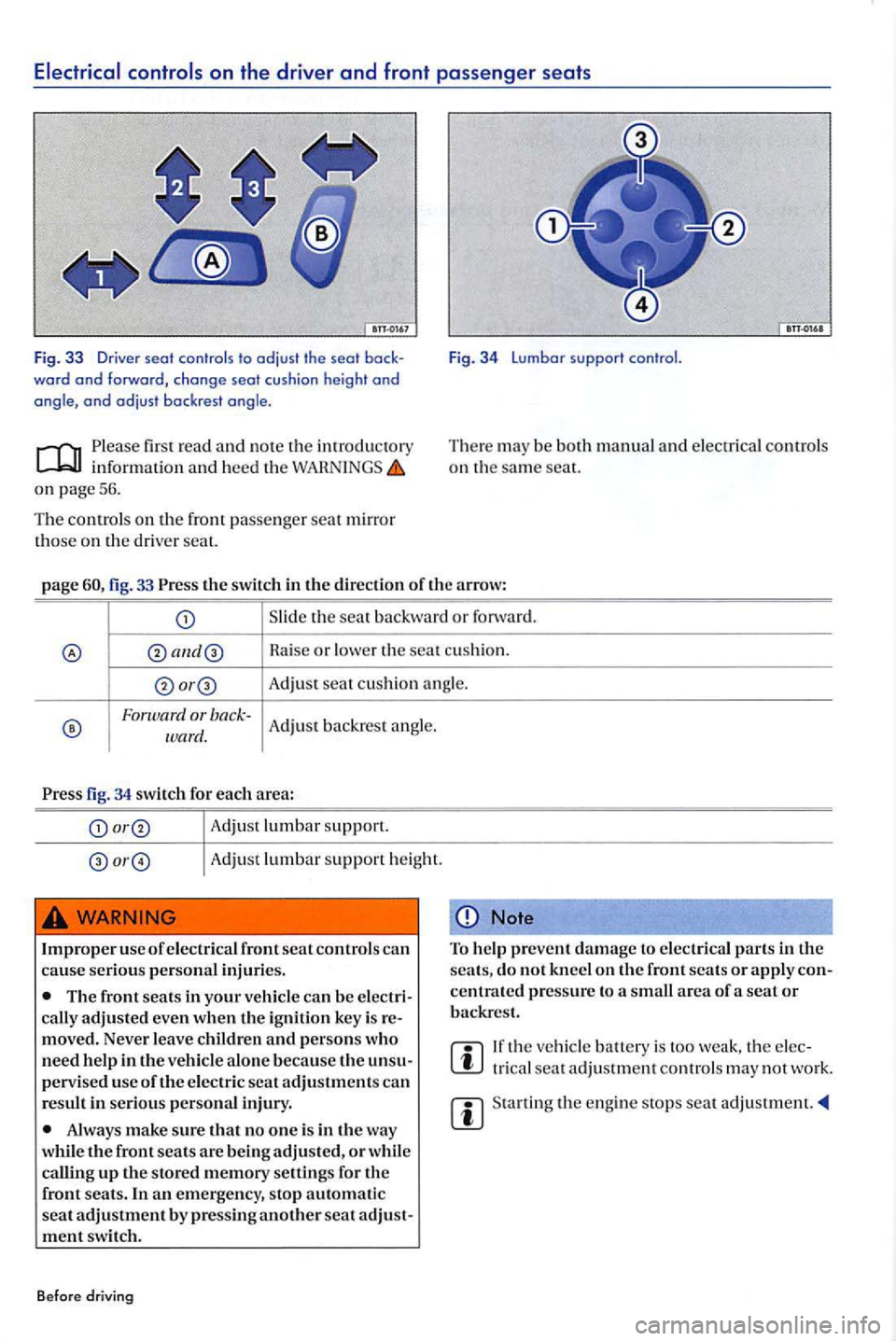
word and forward , change seat cushion height and angle, and adjust backrest angle.
first r ead and note the inf orm atio n and hee d t he WAH N INGS on pag e 56.
T he co ntrols
on f ront passe nge r seat mi rro r on th e driver se at.
F ig. 34 Lumbar su pport control.
T he re m ay be bo th manual and e lectri ca l controls
o n th e sa me seat.
page fig. 33 th e sw itch i n th e d irec tion of th e a rrow:
Slid e th e seat b ackwa rd or forw ard .
Haise or l owe r th e seat cu sh io n .
Adjust sea t c u shi on an gle .
Forw ard or bac k-Adju st b ack res t an gle. ward.
fig. 34 switch f or each area:
Adju st lumbar s upport .
Adjust l umb ar suppo rt heig ht.
WARNING
Im prope r use of e lec tr ica l front sea t control s ca n cause serio us pe rso nal inju ries.
T he front sea ts in your vehicl e ca n b e
moved. Neve r leave children and p erso ns w ho
need h elp in the ve hicl e alo ne beca use the p erv ise d u se oftheelec tric sea t adjustments can
re sult in seriou s personal inju ry.
way
w hil e the front seats are bein g adju ste d, o r w hil e
ca llin g up sto re d m em ory settings for the
fr ont seats . In an em erge ncy, sto p aut om atic
seal adjustment b y pre ss ing a nother seat
N ote
T o help prev ent damage t o e lec trical p arts in the
s ea ts , do no t kn eel o n the front seals o r a ppl y
tr ica l seat adju stm ent contro ls m ay not w ork.
th e e ng in e s to p s se at
Page 66 of 541
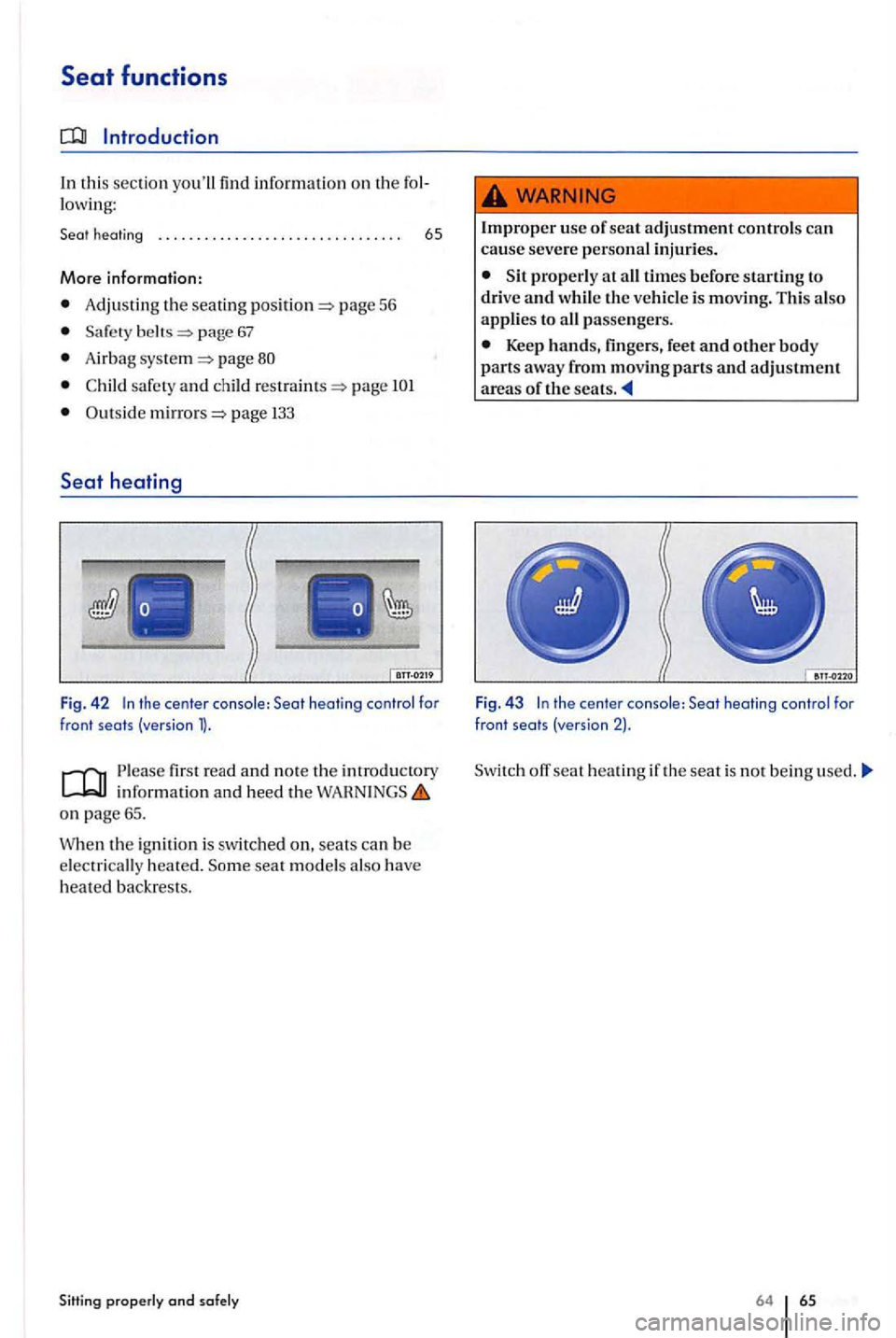
In this sec tion yo u'll find informa tion on the lowing:
h eating . . . . . . . . . . . . . . . . . . . . . . . . . . . . . 65
More information:
Adju stin g th e seati ng page 56
page
A irb ag sys te m p age
safety and child page
Out sid e page
hea ting contr ol for front seats (version
first r ead and note th e introd uctory
o n page 65.
When th e igni tion is sw itched on, seats ca n be
e lec trically heated. sea t models als o have
h ea ted backre sts.
properly and safely
Improper use of seat adjust ment control s can cause seve re personal injuries.
prope rly at all times before starting to
drive and while the vehicl e is moving. This also
applies to all passe ngers.
Keep hands, fingers, feet and other body parts away from moving parts and adjustment areas of th e seats .
Fig . 43 In the center console: healing contr ol for front seats (version 2).
off seat heating if th e seat is not b eing used
64 65
Page 71 of 541
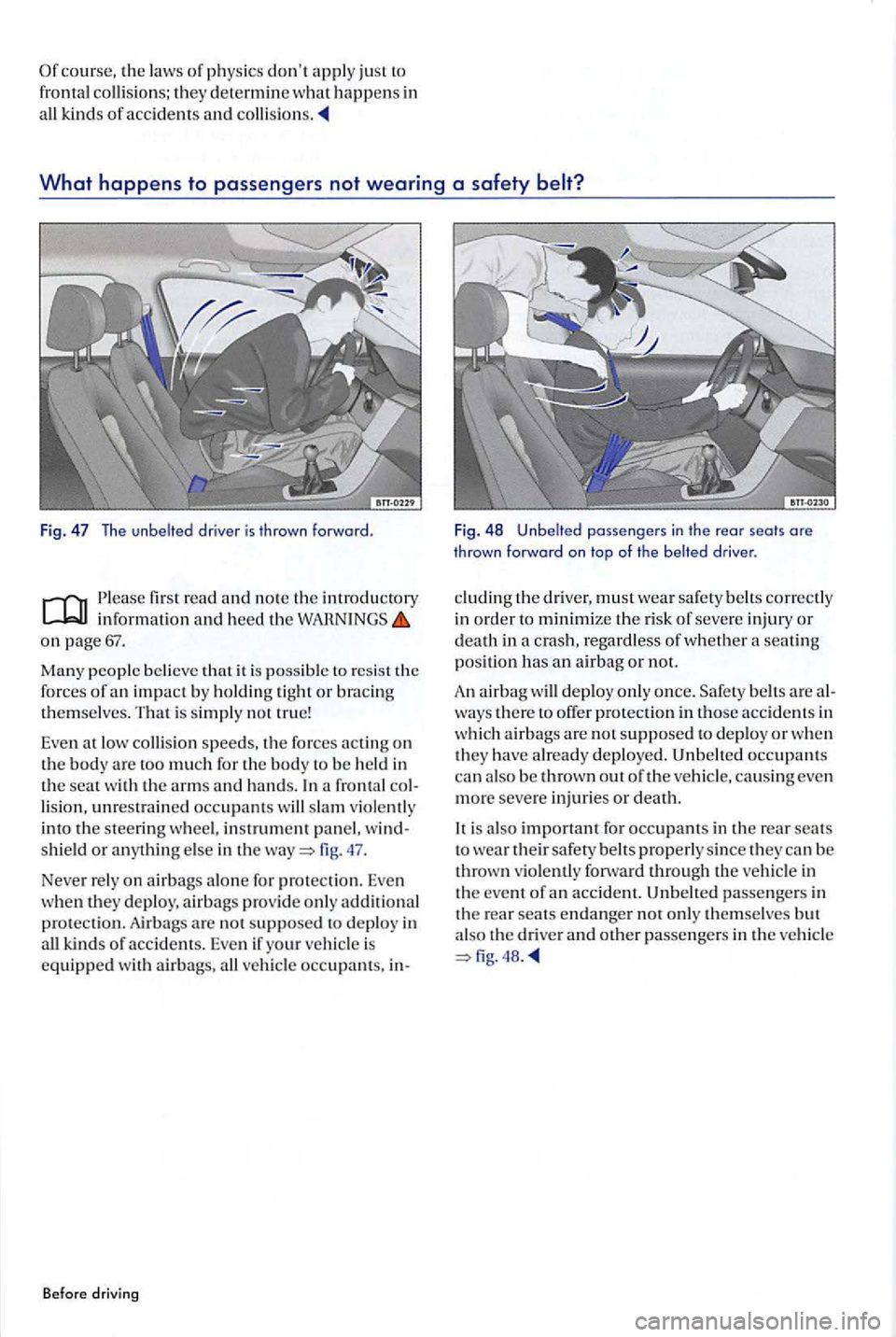
first read and note th e introducto ry information a nd heed on page 67.
Ma ny peopl e believe th at it is possib le to resis t the
forc es of an impact b y holding tight or bracin g themselves. That i s s impl y not true!
Eve n at low collis ion speeds, th e forces acting on th e body are too much for the body to be held in the seat with the arms and hands. a front al collis ion, unrestra in ed occup ants w ill slam v iolentl y
into the s teerin g wheel, instrument pane l, w indshield or anything e lse in the fig . 47.
Neve r rel y on airb ags alone fo r protection. Even
w he n they deploy, airbags pro vide o nl y additional
pro tectio n . Airbag s are no t supposed to deploy in
all kind s of accidents. Even if your ve hicl e is equippe d w ith airbags . all ve hicl e occupants, in -
Before driving F
ig. 48 U
nbelted passengers in the rear seats ore thrown forward on top of th e belted drive r .
eluding the driver, must wear sa fety belts correctly
in order to minimize th e risk of se vere injury o r
d eath in a c rash, regardless of whether
is als o impo rt ant for occupants in the rear seats
t o wea r th eir safety belts properly since they can be thrown vio lently fon vard through th e ve hicl e in
th e event of an accid ent. Unbelted passen ge rs in the rear seats endang er not onl y them se lves but al so th e drive r and other passengers in the vehicl e
Page 72 of 541
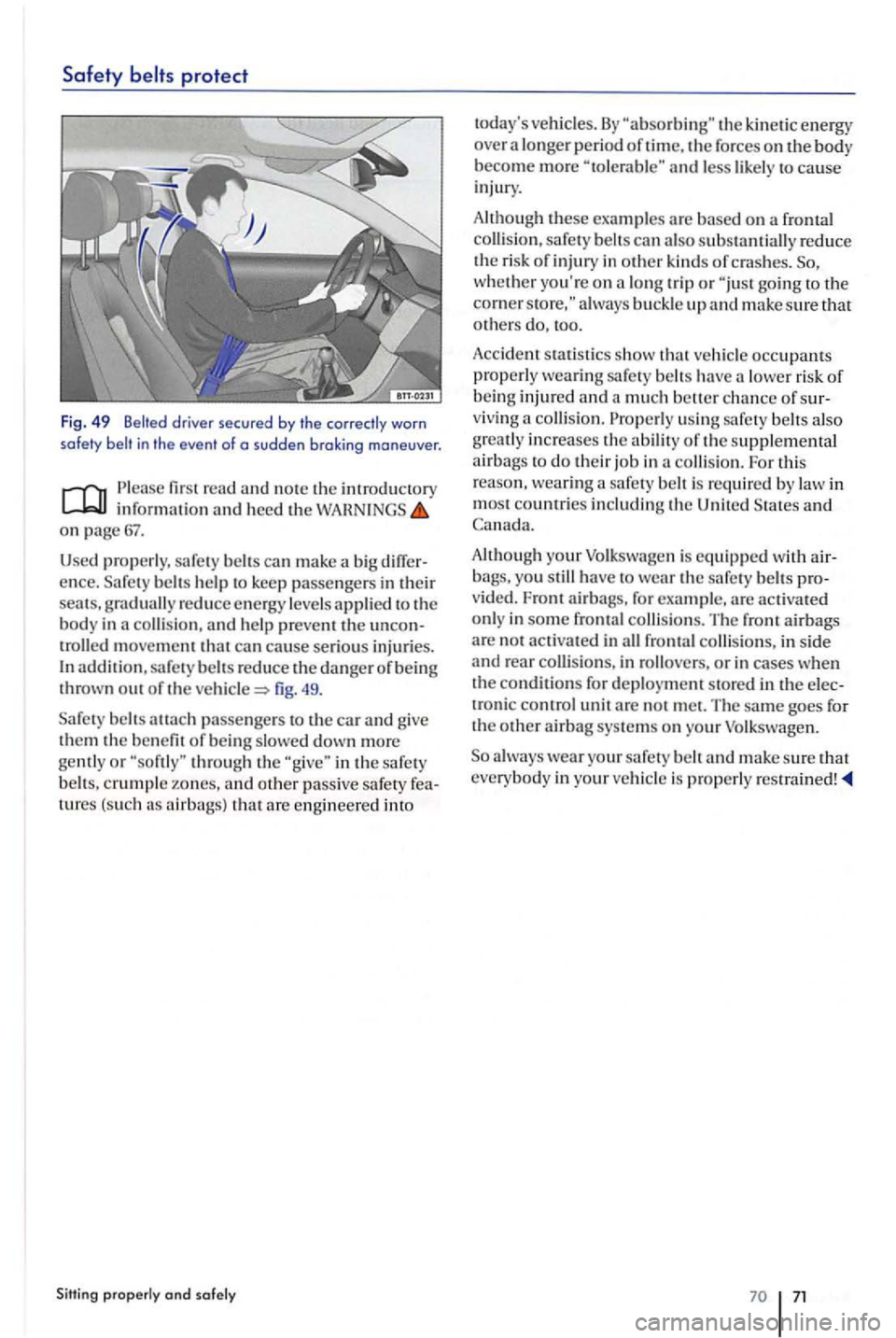
Safety
firs t r ead and no te th e information heed th e on
ence. b elts help to k eep passengers i n th eir seats, graduall y reduce e nergy leve ls appli ed t o th e
b o d y in collision, and help preve nt the can cause seriou s injuries.
I n additi on, safety belts reduce th e danger of b e in g
thro wn out or th e fig. 49.
belts pa ssengers to th e
throug h the in the safety
b elt s. c rumple z ones, lUres (su ch as airbags) that
Sitting
th e kineti c energy
ove r lo nge r perio d of time, th e for ces on th e body
b eco me m ore less lik ely to cause
injury.
A lthou gh these exa mples based on a frontal
c olli sio n, s afet y belt s ca n al so su bsta ntiall y reduce
th e ris k or injury in othe r kind s of cra shes. w heth er you're on lo ng trip or going th e corner always buc kle up
v e hicl e properly wea rin g sa fe ty belt s have low er ris k of b ein g injure d and a much be chance or collis ion. u sing safety belts a lso
gr eatl y in cre ases th e ability or the suppl em ental
airbag s to d o their jo b in collis ion. For this
r e a son, wearing a safety is re q uir ed by in
m os t coumries includin g th e Unit ed and
th e belts vid ed. a irba gs, fo r examp le , ac tivated only in some collisio n s. T he fro nt airbag s are not activa te d in fro ntal collis io ns, in side rear c olli sions, in rollove rs, or in ca se s wh en
th e c onditi ons fo r d eployment sto re d in the
always wea r your safe ty belt and make sure th at
every bo dy in your vehicle is pro perly res train ed!
71
Page 75 of 541
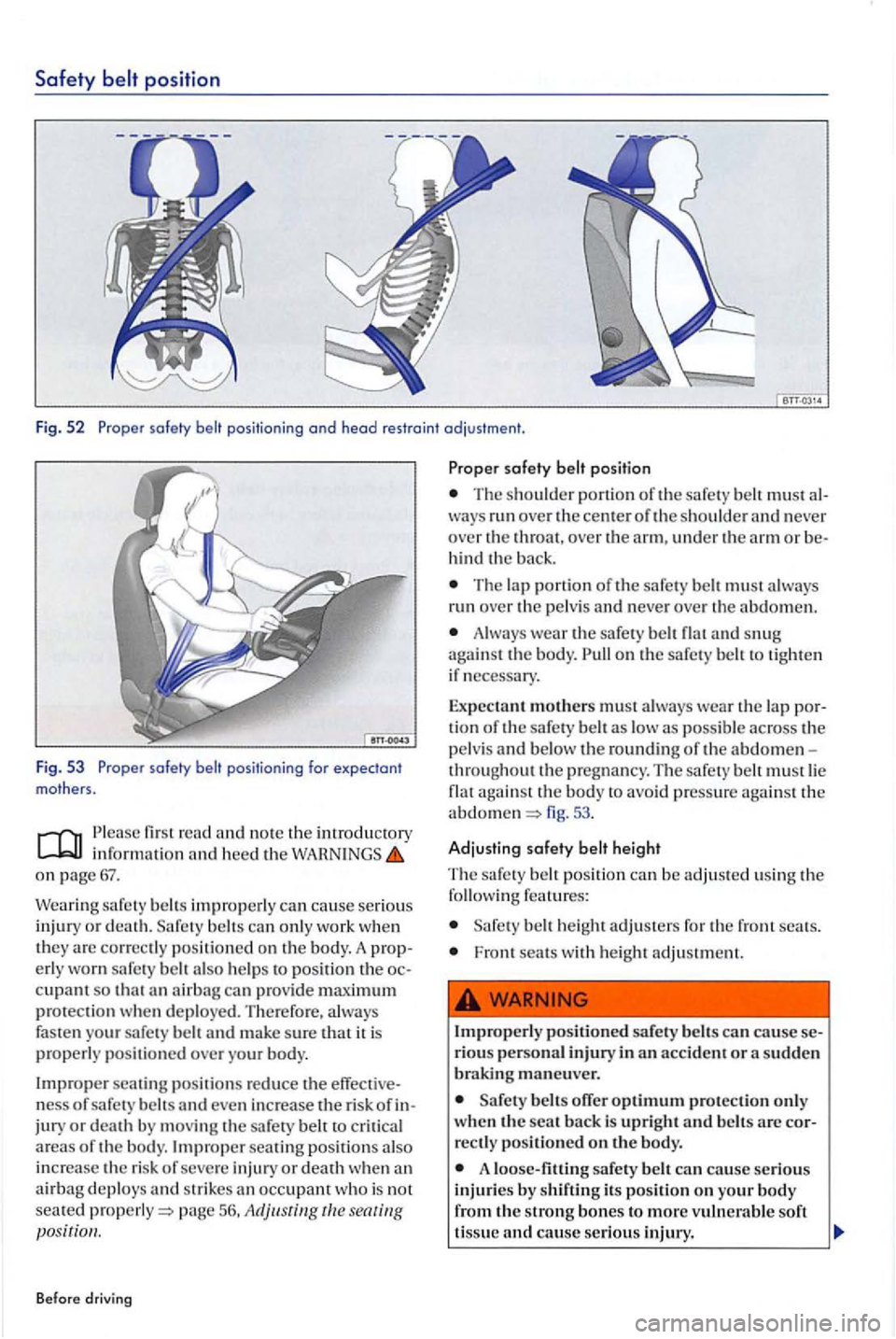
Safety belt position
Fig . 52 Proper
informatio n on
Wea ring safe ty improperly ca n ca use serious
in jury or death. belt s ca n onl y work when they are corr ectly positioned on the body. A worn safe ty be lt also he lp s to position the cupant so that an airb ag can prov ide m aximum protection when deployed. Therefore, always
fasten your safe ty mak e sure that it is properly positioned over your body.
seati ng positi ons reduce the ness of safety jury or death by moving the sa fe ty to critica l
a re as of the body.
Before driving
safety belt position
The sho uld er portio n of the safe ty belt mu st ways run over the cen te r of the shoulder and neve r
ove r the th roat. ove r the arm. under the arm or hin d th e back.
The lap po rtion of the safety mus t ru n ove r th e pelv is a nd neve r over the abdomen.
Always wear th e safe ty a nd snug on the safe ty belt to tight en
if necessary .
Expectant mothers must a lways wear th e lap as low as possible across the pelv is an d below the rounding of the abdomen
throu ghout the pregnancy. The safe ty must lie aga inst th e bod y to avoid pressure against th e abdomen 53.
Adjusting safety belt height
Th e safety posit ion can be adjuste d u sin g the features:
belt he ig ht adju ster s for the front seats.
Fro nt seats with height adjustment.
rio us personal injury in an accident or a sudden braking maneuver.
belt s offer optimum protection onl y when th e seat bac k i s upright and belt s arc rectl y positioned on the body.
A safety belt can cause serious injuries by s hiftjn g its position on your body from the strong bones to more vulnerable s oft
tissu e and cause se riou s injury.
Page 76 of 541
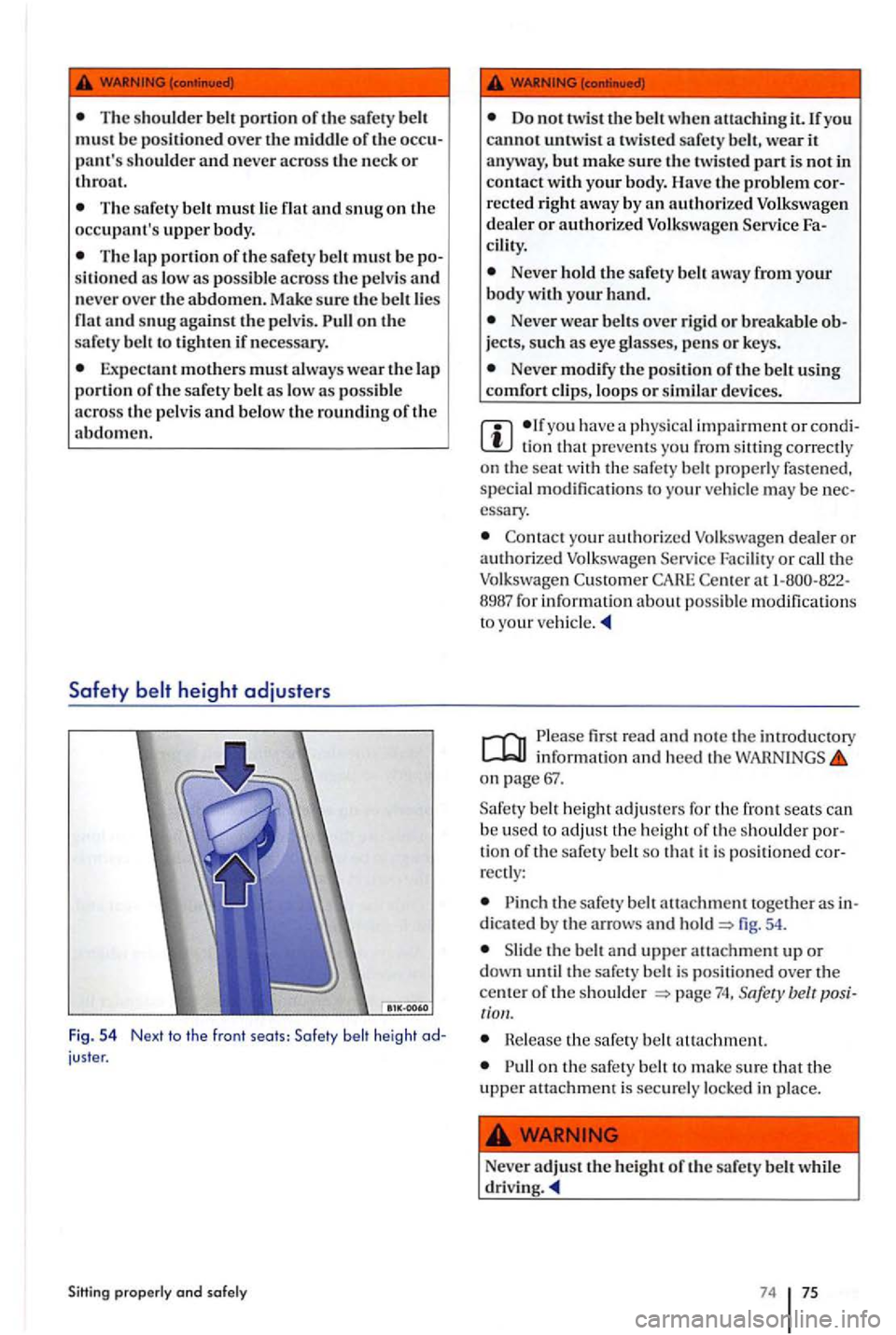
The sh o ulder belt portion of tJ1e safety must be positioned over the middle of the
T he sa fety belt must lie flat and snug on the
occupant's upper body.
T he la p portion of the safe ty belt must be sitioned as low as possible across the pelvis and n eve r over the abdomen. Make sure tJ1e belt lies
flat and snug against th e pelvis. Pull on the safety belt to tighten if necessary.
Expectant mothers mus t always wear the lap portion of the safety be lt as low as poss ibl e
a cross the pelvi s and below tJ1e rounding of the abdomen.
Safety
juster.
Sittin g ond safely
Do no t tw ist the belt wh en auaching it. If yo u cannot untwi st a twis te d sa fe ty belt , w ear it
anyway , but make sure the tw is te d p art is not in contact with your body. Have th e problem
cility .
Neve r hold the safet y belt away from your body your hand.
Never wear belt s over rigid or breakable
Neve r modify the po sition of the b elt usi ng
co mfort clips, loops or similar d evices .
tion that p reve nts yo u f rom siltin g correctly on th e seat w ith the safe ty belt p ro perly fastened,
spec ia l modifica tions to yo ur vehicle may be essary.
Contact your authorized Volkswage n dealer or
auth orized Volkswage n Facility or call th e Volksw agen CARE 8987 for informatio n abo ut po ssibl e modifications to you r vehicle .
Please fir st rea d and note the introduc tory informatio n and heed the on page
belt h eig ht adju ste rs for the front seats can
b e used to adj us t th e he ig ht of th e sh o uld er tio n of th e sa fety belt so th at it is po sit ioned
th e safe ty belt auachm emtogethe r as dica ted by the arro ws an d fig. 54.
th e belt and upper auachm ent up or d own th e safe ty belt is positioned over the
ce nter of th e should er tio n.
th e safe ty belt a uach mc nt.
on th e sa fe ty belt to mak e sur e th at th e
up pe r atta chment is sec ure ly loc ke d in place.
adjust the height of the safe ty belt while
Page 81 of 541

Airbag system
find information on th e fol
low ing :
Advanced Airbog
. 82
. . . . . .
Advanced Airbog Sys tem compon e nt s . . . . . . . . . . 93
H ow to if the passenger fron t oirbog is on or off 9 5
. . . . . . 98
Your vehicle is e quipped a front air bag for the
d ri ve r an d fro nt pa sse nger. The front airbag s can pro vide additional p ro tec tion fo r th e ch est and h ead of th e driver and the fro nt sea t p assenge r seats, sa fe ty belts, h ead re stra int s and, for
the driver, th e s teerin g whee l, are prop erly use d and have bee n properly adjusted. Airb ags are on ly
s u pplemental restraints. Th ey are not a su bstitut e for sa fe ty belt s th at must be wo rn eve n though front seatin g pos itions are equipp ed wit h front air
bag s.
More information:
Driv ing instru ction s=> page
seating position=> pag e 56
Safe ty belts=> page 67
sa fe ty and child pa ge
care and pag e
accessories, re pa ir s and modifica tion s pag e303
informati on=> page 311
Never rely on a irbags alone for protect io n.
Eve n when th ey deploy, airbags provide only
s uppl em ental protec tion.
Be fore driving
Airbag s work most effec tive ly w hen used
with properl y worn safe ty belt s=> page 67,
Every perso n in the ve hicl e must b e prop erl y seated on a seat of hi s or he r own, must properl y faste n th e safet y belt belongi ng to th at seat b e
for e the vehicle sta rt s to move, and must ke ep the belt properly faste n ed whil e riding in the ve
hicle. Th is a pplie s to the driv er and all
Obj ects between you an d the airbag will crease the risk of injury in a crash by interfe rin g
witl1the way the airbag unfolds or by being push ed into you as the a irbag inflates.
Never h old th ings in your hand s or on your lap when the vehicl e is in use.
Never items on or in th e area of th e
front passe nger seat. Ob jects could move into
th e a rea of the front airbag s during braking or other sudden maneu ve rs and fly dan gero usly
through the passe nge r compartment when an airbag infl ates.
The airbag deploym ent zones must be kept
clear at all tim es. Make sure there are no objects ,
pets, or ot her persons in the space be tween any ve hicl e occupant and any airb ag at an y time. Thi s also applie s to c hildr en and o ther pa sse n
gers .
WARNING-
An airb ag works o nl y once. Airbag s th a t h ave de
plo yed in a cras h must be re placed.
Deployed airbag s and the re lated sys tem
p art s must b e repla ced immediately with new parts approved for the ve hicl e by Volkswagen.
Use o nly orig inal equipment airb ags ap
prov ed by Volkswag en and by a trained
techni cian who has the necessary too ls and di
agnostic eq uipmen t to properl y replace an y airbag in your ve hi cle and assure sys te m effec-
ti veness in a c rash.